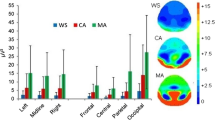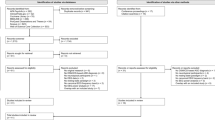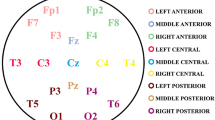Abstract
We quantified the potential effects of physiologic artifact on the estimation of EEG band power in a cohort of typically developing children in order to guide artifact rejection methods in quantitative EEG data analysis in developmental populations. High density EEG was recorded for 2 min while children, ages 2–6, watched a video of bubbles. Segments of data were categorized as blinks, saccades, EMG or artifact-free, and both absolute and relative power in the theta (4–7 Hz), alpha (8–12 Hz), beta (13–30 Hz) and gamma (35–45 Hz) bands were calculated in 9 regions for each category. Using a linear mixed model approach with artifact type, region and their interaction as predictors, we compared mean band power between clean data and each type of artifact. We found significant differences in mean relative and absolute power between artifacts and artifact-free segments in all frequency bands. The magnitude and direction of the differences varied based on power type, region, and frequency band. The most significant differences in mean band power were found in the gamma band for EMG artifact and the theta band for ocular artifacts. Artifact detection strategies need to be sensitive to the oscillations of interest for a given analysis, with the most conservative approach being the removal of all EMG and ocular artifact from EEG data. Quantitative EEG holds considerable promise as a clinical biomarker of both typical and atypical development. However, there needs to be transparency in the choice of power type, regions of interest, and frequency band, as each of these variables are differentially vulnerable to noise, and therefore, their interpretation depends on the methods used to identify and remove artifacts.




Similar content being viewed by others
References
Barry, R. J., Clarke, A. R., Hajos, M., McCarthy, R., Selikowitz, M., & Dupuy, F. E. (2010). Resting-state EEG gamma activity in children with attention-deficit/hyperactivity disorder. Clinical Neurophysiology, 121(11), 1871–77.
Benninger, C., Matthis, P., & Scheffner, D. (1984). EEG development of healthy boys and girls. Results of a longitudinal study. Electroencephalography and Clinical Neurophysiology, 57(1), 1–12.
Bonfiglio, L., Olcese, U., Rossi, B., Frisoli, A., Arrighi, P., Greco, G., Carozzo, S., Andre, P., Bergamasco, M., & Carboncini, M. C. (2013). Cortical source of blink-related delta oscillations and their correlation with levels of consciousness. Human Brain Mapping, 34(9), 2178–89.
Bosl, W., Tierney, A., Tager-Flusberg, H., & Nelson, C. (2011). EEG complexity as a biomarker for autism spectrum disorder risk. BMC Medicine, 9, 18.
Cantor, D. S., & Chabot, R. (2009). QEEG studies in the assessment and treatment of childhood disorders. Clinical EEG and Neuroscience, 40(2), 113–21.
Clarke, A. R., Barry, R. J., Dupuy, F. E., Heckel, L. D., McCarthy, R., Selikowitz, M., & Johnstone, S. J. (2011). Behavioural differences between EEG-defined subgroups of children with Attention-Deficit/Hyperactivity Disorder. Clinical Neurophysiology, 122(7), 1333–41.
Dawson, G., Jones, E. J., Merkle, K., Venema, K., Lowy, R., Faja, S., & Webb, S. J. (2012). Early behavioral intervention is associated with normalized brain activity in young children with autism. Journal of the American Academy of Child and Adolescent Psychiatry, 51(11), 1150–59.
Deen, B., & Pelphrey, K. (2012). Perspective: brain scans need a rethink. Nature, 491(7422), S20.
Drongelen, W. (2007). Signal processing for neuroscientists : introduction to the analysis of physiological signals. Amsterdam. Burlington: Elsevier/Academic Press.
Elliott, C. D. (1993). Differential abilities scale (DAS). Child Assessment News, 3, 1–10.
Ferree, T. C., Luu, P., Russell, G. S., & Tucker, D. M. (2001). Scalp electrode impedance, infection risk, and EEG data quality. Clinical Neurophysiology, 112(3), 536–44.
Fletcher, E. M., Kussmaul, C. L., & Mangun, G. R. (1996). Estimation of interpolation errors in scalp topographic mapping. Electroencephalography and Clinical Neurophysiology, 98(5), 422–34.
Freeman, W. J., Holmes, M. D., Burke, B. C., & Vanhatalo, S. (2003). Spatial spectra of scalp EEG and EMG from awake humans. Clinical Neurophysiology, 114(6), 1053–68.
Goncharova, I. I., McFarland, D. J., Vaughan, T. M., & Wolpaw, J. R. (2003). EMG contamination of EEG: spectral and topographical characteristics. Clinical Neurophysiology, 114(9), 1580–93.
Gou, Z., Choudhury, N., & Benasich, A. A. (2011). Resting frontal gamma power at 16, 24 and 36 months predicts individual differences in language and cognition at 4 and 5 years. Behavioural Brain Research, 220(2), 263–70.
Grasser, T., Lothar, S., & Joachim, M. (1985). The transfer of EOG activity into the EEG for eyes open and closed. Electroencephalography and Clinical Neurophysiology, 61, 181–93.
Gratton, G., Coles, M. G., & Donchin, E. (1983). A new method for off-line removal of ocular artifact. Electroencephalography and Clinical Neurophysiology, 55(4), 468–84.
Hagemann, D., & Naumann, E. (2001). The effects of ocular artifacts on (lateralized) broadband power in the EEG. Clinical Neurophysiology, 112(2), 215–31.
Iacono, W. G., & Lykken, D. T. (1981). Two-year retest stability of eye tracking performance and a comparison of electro-oculographic and infrared recording techniques: evidence of EEG in the electro-oculogram. Psychophysiology, 18(1), 49–55.
Jasper, H. H. (1958). The ten-twenty electrode system of the International Federation. Electroencephalography and Clinical Neurophysiology, 10, 371–75.
Jeste SS, Kirkham N, Senturak D, Hasenstab K, Sugar C, Kupelian C, Baker E, Sanders AJ, Shimizu C, Norona A, Paparella T, Freeman S, Johnson SP. Dev Sci 2014; Electrophysiological evidence of heterogeneity in visual statistical learning in young children with ASD. June 11. Epub ahead of print.
John, E. R., Ahn, H., Prichep, L., Trepetin, M., Brown, D., & Kaye, H. (1980). Developmental equations for the electroencephalogram. Science, 210(4475), 1255–58.
Jung, T. P., Makeig, S., Westerfield, M., Townsend, J., Courchesne, E., & Sejnowski, T. J. (2000). Removal of eye activity artifacts from visual event-related potentials in normal and clinical subjects. Clinical Neurophysiology, 111(10), 1745–58.
Keil, A., Debener, S., Gratton, G., Junghofer, M., Kappenman, E. S., Luck, S. J., Luu, P., Miller, G. A., & Yee, C. M. (2014). Committee report: Publication guidelines and recommendations for studies using electroencephalography and magnetoencephalography. Psychophysiology , 51(1), 1–21.
Keren, A. S., Yuval-Greenberg, S., & Deouell, L. Y. (2010). Saccadic spike potentials in gamma-band EEG: characterization, detection and suppression. Neuroimage, 49(3), 2248–2263.
Leuchter, A. F., Cook, I. A., Marangell, L. B., Gilmer, W. S., Bugoyne, K. S., Howland, R. H., Trivedi, M. H., Zisook, S., Jain, R., McCracken, J. T., Fava, M., Iosifescu, D., & Greenwald, S. (2009). Comparative effectiveness of biomarkers and clinical indicators for predicting outcomes of SSRI treatment in major depressive disorder: results of the BRITE-MD study. Psychiatry Research, 169(2), 124–31.
Loo, S. K., & Makeig, S. (2012). Clinical utility of EEG in attention-deficit/hyperactivity disorder: a research update. Neurotherapeutics, 9(3), 569–87.
Luckhaus, C., Grass-Kapanke, B., Blaeser, I., Ihl, R., Supprian, T., Winterer, G., & Brinkmeyer, J. (2008). Quantitative EEG in progressing vs stable mild cognitive impairment (MCI): results of a 1-year follow-up study. International Journal of Geriatric Psychiatry, 23(11), 1148–55.
Marshall, P. J., Bar-Haim, Y., & Fox, N. A. (2002). Development of the EEG from 5 months to 4 years of age. Clinical Neurophysiology, 113(8), 1199–1208.
Monastra, V. J., Lubar, J. R., Linden, M., VanDeusen, P., Green, G., Wing, W., Phillips, A., & Fenger, T. N. (1999). Assessing attention deficit hyperactivity disorder via quantitative electroencephalography: an initial validation study. Neuropsychology, 13(3), 424–33.
Mullen, E. M. (1995). Mullen scales of early learning: AGS edition. Circle Pines: American Guidance Service.
Nunez, P. L., & Srinivasan, R. (2006). Electric fields of the brain: the neurophysics of EEG (2nd ed.). Oxford. New York: Oxford University Press.
Oh, J., Han, M., Peterson, B. S., & Jeong, J. (2012). Spontaneous eyeblinks are correlated with responses during the Stroop task. PLoS One, 7(4), e34871.
Onton, J., Westerfield, M., Townsend, J., & Makeig, S. (2006). Imaging human EEG dynamics using independent component analysis. Neuroscience and Biobehavioral Reviews, 30(6), 808–22.
Perrin, F., Pernier, J., Bertrand, O., Giard, M. H., & Echallier, J. F. (1987). Mapping of scalp potentials by surface spline interpolation. Electroencephalography and Clinical Neurophysiology, 66(1), 75–81.
Picton, T. W., Bentin, S., Berg, P., Donchin, E., Hillyard, S. A., Johnson, R., Miller, G. A., Ritter, W., Ruchkin, D. S., Rugg, M. D., & Taylor, M. J. (2000). Guidelines for using human even-related potentials to study cognition: Recording standards and publication ciriteria. Psychophysiology, 37(2), 127–52.
Pivik, R. T., Broughton, R. J., Coppola, R., Davidson, R. J., Fox, N., & Nuwer, M. R. (1993). Guidelines for the recording and quantatative analysis of electroencephalographic activity in research contexts. Psychophysiology, 30(6), 547–58.
Pizzagalli, D. (2007). Electroencephalography and high-density electrophysiological source localization. In J. Cacioppo, L. G. Tassinary, & G. G. Berntson (Eds.), The handbook of psychophysiology (pp. 56–85). Cambridge: Cambridge University Press.
Power, J. D., Barnes, K. A., Snyder, A. Z., Schlaggar, B. L., & Petersen, S. E. (2012). Spurious but systematic correlations in functional connectivity MRI networks arise from subject motion. NeuroImage, 59, 2142–54.
Saby, J. N., & Marshall, P. J. (2012). The utility of EEG band power analysis in the study of infancy and early childhood. Developmental Neuropsychology, 37(3), 253–73.
Satterthwaite, T. D., Wolf, D. H., Loughead, J., Ruparel, K., Elliot, M. A., Hakonarson, H., Gur, R. C., & Gur, R. E. (2012). Impact of in-scanner head motion on multiple measures of functional connectivity: relevance for studies of neurodevelopment in youth. NeuroImage, 60(1), 623–32.
Slifer, K. J., Avis, K. T., & Frutchey, R. A. (2008). Behavioral intervention to increase compliance with electroencephalographic procedures in children with developmental disabilities. Epilepsy and Behavior, 13(1), 189–95.
Snyder, S. M., & Hall, J. R. (2006). A meta-analysis of quantitative EEG power associated with attention-deficit hyperactivity disorder. Journal of Clinical Neurophysiology, 23(5), 440–55.
Sparrow, S. S., Cicchetti, D. V., & Balla, D. A. (2005). Vineland adaptive behavior scales (2nd ed.). Livonia: Pearson Assessments.
Srinivasan, R., Nunez, P. L., Tucker, D. M., Silberstein, R. B., & Cadusch, P. J. (1996). Spatial sampling and filtering of EEG with spline laplacians to estimate cortical potentials. Brain Topography, 8(4), 355–66.
Swingler, M. M., Willoughby, M. T., & Calkins, S. D. (2011). EEG power and coherence during preschoolers’ performance of an executive function battery. Developmental Psychobiology, 53(8), 771–84.
Tierney, A. L., Gabard-Durnam, L., Vogel-Farley, V., Tager-Flusberg, H., & Nelson, C. A. (2012). Developmental trajectories of resting EEG power: an endophenotype of autism spectrum disorder. PLoS ONE, 7(6), e39127.
Uhlhaas, P. J., Roux, F., Rodriguez, E., Rotarska-Jagiela, A., & Singer, W. (2010). Neural synchrony and the development of cortical networks. Trends in Cognitive Sciences, 14(2), 72–80.
Van Dijk, K. R., Sabuncu, M. R., & Buckner, R. L. (2012). The influence of head motion on intrinsic functional connectivity MRI. NeuroImage, 59(1), 431–38.
Wang, J., Barstein, J., Ethridge, L. E., Mosconi, M. W., Takarae, Y., & Sweeney, J. A. (2013). Resting state EEG abnormalities in autism spectrum disorders. Journal of Neurodevelopmental Disorders, 5(1), 24.
Webb SJ, Bernier R, Henderson HA, Johnson MH, Jones EJ, Lerner MD, Westerfield M. Guidelines and Best Practices for Electrophysiological Data Collection, Analysis and Reporting in Autism. J Autism Dev Disord 2013
Whitham, E. M., Pope, K. J., Fitzgibbon, S. P., Lewis, T., Clark, C. R., Loveless, S., Broberg, M., Wallace, A., DeLosAngeles, D., Lillie, P., Hardy, A., Fronsko, R., Pulbrook, A., & Willoughby, J. O. (2007). Scalp electrical recording during paralysis: quantatative evidence that EEG frequencies above 20 Hz are contaminated by EMG. Clinical Neurophysiology, 118(8), 1877–88.
Yuval-Greenberg, S., & Deouell, L. Y. (2009). The broadband-transient induced gamma-band response in scalp EEG reflects the execution of saccades. Brain Topography, 22(1), 3–6.
Yuval-Greenberg, S., Tomer, O., Keren, A. S., Nelken, I., & Deouell, L. Y. (2008). Transient induced gamma-band response in EEG as a manifestation of miniature saccades. Neuron, 58(3), 429–41.
Acknowledgments
This research was funded by NIMH 5K23MH094517 – 02 (PI Jeste) and the Autism Speaks Weatherstone Predoctoral Fellowship 7845 (McEvoy, Kevin).
Conflict of Interest
Kevin McEvoy Kyle Hasenstab, Damla Senturk, Andrew Sanders, and Shafali S. Jeste declare that they have no conflicts of interest.
Informed Consent
All procedures followed were in accordance with the ethical standards of the responsible committee on human experimentation (institutional and national) and with the Helsinki Declaration of 1975, and the applicable revisions at the time of the investigation. Informed consent was obtained from all patients for being included in the study.
Author information
Authors and Affiliations
Corresponding author
Rights and permissions
About this article
Cite this article
McEvoy, K., Hasenstab, K., Senturk, D. et al. Physiologic artifacts in resting state oscillations in young children: methodological considerations for noisy data. Brain Imaging and Behavior 9, 104–114 (2015). https://doi.org/10.1007/s11682-014-9343-7
Published:
Issue Date:
DOI: https://doi.org/10.1007/s11682-014-9343-7




